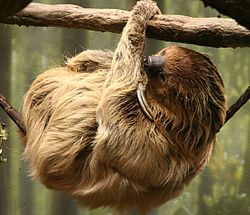Megalonychidae
|
Megalonychidae Temporal range: 35–0 Ma Early Oligocene to Recent |
|
|---|---|
 |
|
| Choloepus didactylus | |
| Scientific classification | |
| Kingdom: | Animalia |
| Phylum: | Chordata |
| Class: | Mammalia |
| Superorder: | Xenarthra |
| Order: | Pilosa |
| Family: |
Megalonychidae Gervais, 1855 |
| Subfamilies | |
|
see text |
|
see text
Megalonychidae is a group of sloths including the extinct Megalonyx and the living two toed sloths. Megalonychids first appeared in the early Oligocene, about 35 million years ago, in southern Argentina (Patagonia), and spread as far as the Antilles by the early Miocene. Megalonychids first reached North America by island-hopping, about 9 million years ago, prior to the formation of the Isthmus of Panama. Some lineages of megalonychids increased in size as time passed. The first species of these were small and may have been partly tree-dwelling, whereas the Pliocene (about 5 to 2 million years ago) species were already approximately half the size of the huge Megalonyx jeffersonii from the last ice age. Some West Indian island species were as small as a large cat; their dwarf condition typified both tropical adaptation and their restricted island environment. This small size also enabled them a degree of arboreality.
Megalonychid ground sloths became extinct in North and South America around the end of the , and in the Antilles apparently by about 5000 BP, leaving two-toed tree sloths of genus Choloepus as the only surviving members of the family.
Megalonyx, which means "giant claw," is a widespread North American genus that lived past the close of the last (Wisconsin) glaciation, when so many large mammals died out. Remains have been found as far north as Alaska and the Yukon. Ongoing excavations at Tarkio Valley in southwest Iowa may reveal something of the familial life of Megalonyx. An adult was found in direct association with two juveniles of different ages, suggesting that adults cared for young of different generations.
...
Wikipedia
